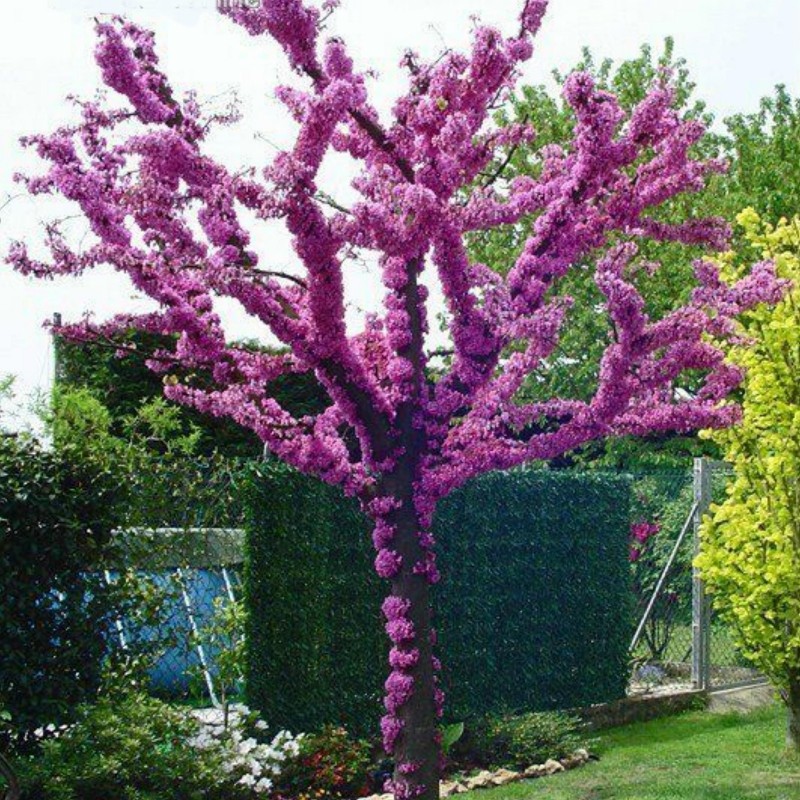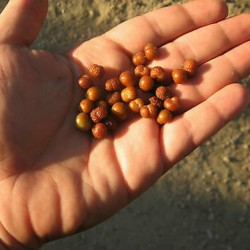

Product with time reduced price

Wild currant seeds (Grewia...
- -€0.01







Cercis siliquastrum, commonly known as the Judas tree, is a small deciduous tree from Southern Europe and Western Asia which is noted for its prolific display of deep pink flowers in spring. This species forms
Cercis siliquastrum, commonly known as the Judas tree, is a small deciduous tree from Southern Europe and Western Asia which is noted for its prolific display of deep pink flowers in spring.
This species forms a small tree up to 12 meters in height and 10 meters in width.
The deep pink flowers are produced on year-old or older growth, including the trunk in late spring (cauliflory). The leaves appear shortly after the first flowers emerge. These are heart-shaped with a blunt apex, which occasionally has a shallow notch at the tip. The tree produces long flat pods that hang vertically. The flowers are edible and purportedly have a sweet-acid taste.
The species was first described by Linnaeus in 1753 and he gave it the specific epithet of siliquastrum which is derived from the Latin word siliqua, meaning "pod".[2] The generic name comes from the Greek kerkis, a "shuttle", which refers to the resemblance shown to this weaver's tool by the flat, woody seedpods.
There is a long-standing myth that Judas Iscariot hanged himself from a tree of this species. This belief is related to the common name "Judas Tree" which is possibly a corrupted derivation from the French common name, Arbre de Judée meaning tree of Judea, referring to the hilly regions of that country where the tree used to be common. Another possible source for the vernacular name is the fact that the flowers and seedpods can dangle directly from the trunk in a way reminiscent of Judas' suicide.
The flowers are pollinated by bees, attracted by nectar. Pollen from the protruding stamens is deposited on the bee's body and carried to another flower's stigma.
|
Cultivation details |
|
|
Succeeds in most soils and pH types, but dislikes growing in wet soils, especially when these are of clay. Prefers a deep sandy loam and a very sunny position. Thrives on chalk and in dry sandy soils. Probably does best on a poorish soil. Succeeds in light shade. Dislikes drought. Dormant plants are hardy to about -15°c. The young growth in spring, even on mature plants, is frost-tender and so it is best to grow the plants in a position sheltered from the early morning sun. Plants do not generally thrive at Kew, they prefer a hotter, continental climate in order to fully ripen their wood. One report says that plants require cool greenhouse treatment in Britain, though several good specimens have been seen outdoors in this country. The tree often does not flower freely in Britain, especially if the previous summer was cool. Plants are susceptible to coral spot fungus, especially when growing in areas with cool summers where the wood is not fully ripened. Plants in this genus are notably resistant to honey fungus. Resents root disturbance, plants should be planted into their permanent positions as soon as possible, preferably in May, and should be kept well watered until established. Any pruning is best carried out in the winter. A very ornamental plant, flowering well in Cornwall. It flowers better when growing in a continental climate. The flowers are produced on the branches of the previous or earlier years, and also on the trunk of the plant. A good bee plant. This species has a symbiotic relationship with certain soil bacteria, these bacteria form nodules on the roots and fix atmospheric nitrogen. Some of this nitrogen is utilized by the growing plant but some can also be used by other plants growing nearby. |
|
Data sheet

 Reviews (0)
Reviews (0)